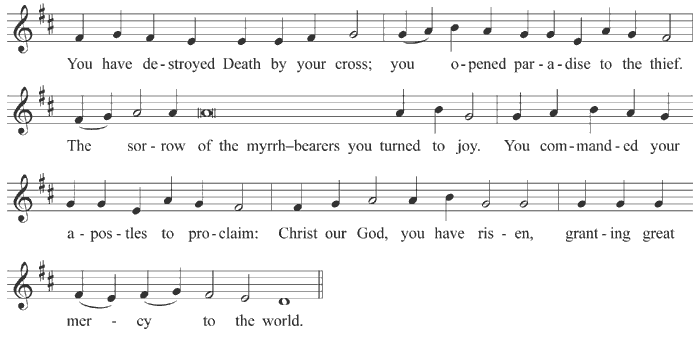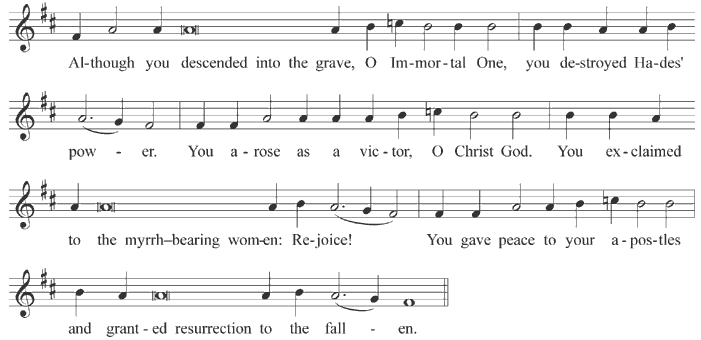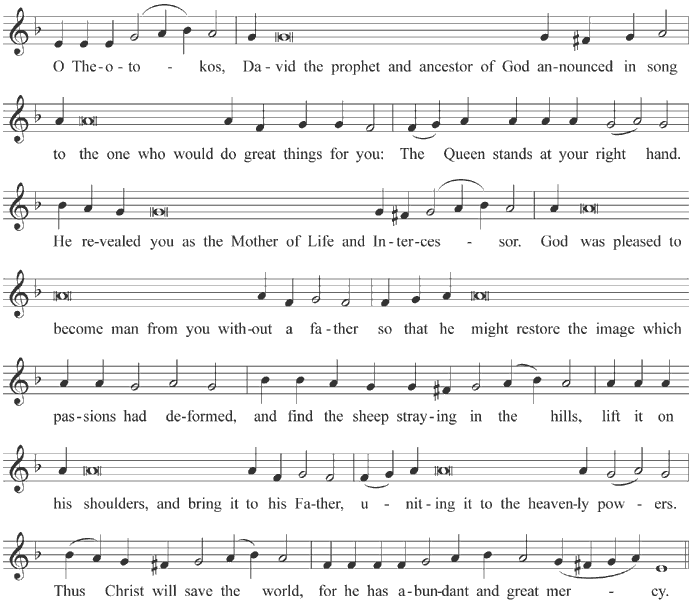The Structure of a Prostopinije Melody
Note: this article explains the structure common to prostopinije melodies in the eight-tone system. It does not apply to music outside the eight-tone system, such as the responses and fixed hymns of the various liturgical services.
The prostopinije melodies for singing texts in the eight-tone system - troparia, kontakia, stichera and prokeimena - have to be able to accommodate texts of any length, while being clear to the listener and straight-forward for the singer. To do this, each melody is built out of melodic phrases which are repeated in a set, traditional order. The phrases can grow or shrink to fit the length of the each text phrase, while the number of musical phrases can vary to match the the number of text phrases in a particular hymn.
To see how this works, consider a single troparion, the Troparion of the Resurrection for Sundays in tone 7:
You have destroyed death by your cross; * you opened paradise to the thief. The sorrow of the myrrh-bearers you turned to joy. * You commanded your apostles to proclaim: * Christ our God, you have risen, * granting great mercy to the world.
Here is the text as set to the Tone 7 troparion melody:
The Initial Phrase(s)
Some melodies have one or two melodic phrases which are only used once, for the corresponding number of text phrases at the start of each text. The Tone 7 troparion melody has a single phrase of this type, which is used here to sing the words, "You have destroyed death by your cross":
When teaching the melody, we label such a phrase with the letter I for Initial. If there are two initial phrases, used to sing the first two text phrases, we label them I1 and I2.
The Repeating Phrases
While a few prostopinije melodies have a fixed number of phrases (say, seven - with some being simply omitted if there are fewer than seven phrases in the text being sung), most use a group of phrases which are repeated, in order, until the necessary number of text phrases has been sung. We label these melody phrases A, B, C, and so on.
The tone 7 troparion melody has two repeating phrases - thus, we call them A and B.
The A phrase is used to sing the next text phrase after the initial phrase:
The next or B phrase is used to sing the text phrase that follows:
Since there are only two repeating musical phrases, we use the A melody again for the next text phrase:
Notice that this melody is not QUITE identical to the way we sang it earlier; the first two notes were sung differently - one syllable per note this time, instead of slurred together - so that the accented syllable on "comMANDed" would land on the high note of the phrase; and we sang four notes ("your apostles") this time where before we only sang three ("paradise"). This sort of adaptation of the melody to the text is a feature of prostopinije, and is done almost automatically by an experienced cantor. (See the article on melodic patterns and the explanations of the individual melodies to see how this works.)
The next phrase is sung to the B melody, with the same sort of small adaptations we saw in the repetition of the A melody:
The Final Phrases
Some prostopinije melodies continue the repeating phrases until the very end. But most have a final phrase melody - which is used to sing the last phrase of the text, and which we label F for Final. The final phrase melody is often more ornate, and brings the entire hymn to a close.
Here is the final phrase of our sample troparion:
So we could describe the pattern of the Tone 7 troparion melody as
I (A B) F
where the parentheses mark the part of the melody that repeats as many times as necessary. Thus, depending on the number of phrases in a given troparion, we might actually sing:
I A B F
I A B A B F
I A B A B A B A F
Any one of the repeating phrases might be followed by the final phrase, so the cantor must be prepared to make the appropriate transition.
Some Examples
The Paschal Kontakion (that is, the kontakion of the Easter Divine Liturgy) is marked in the liturgical books as being in "Tone 8" - so we sing it to the Tone 8 kontakion melody. This melody has neither an initial nor a final phrase; it consists of two repeating phrases (A and B). Try to identify which is which!
The Tone 4 samohlasen melody has two initial phrases, three repeating phrases, and a final phrase: I1 I2 (A B C) F. To illustrate it, we use a longer sticheron (called the dogmatikon) from Sunday Vespers in Tone 4:
Applying a Melody to a Text
In the examples so far, the text to be sung has already been written out with music. How do you apply a particular prostopinije melody to a liturgical text - one for which no music is available?
First, determine the type of hymn (troparion, kontakion or sticheron), and the tone. This will generally be indicated in the liturgical book that contains the hymn. From this information, you should be able to select the proper prostopinije melody to use. (Note: sometimes a special melody called a podoben will be indicated instead.)
Second, divide the text of the hymn into phrases of moderate length that "make sense" - that is, that match the way the text would be read aloud, with phrase divisions at about the places where you would pause naturally when reading. Sometimes the particular melody being used will influence your choice. For example, some melodies have a very long or very short initial phrase, and this may need to be taken into account. By tradition, we use asterisks (*) to mark the divisions between phrases. (See the example at the top of this article!)
Third, set each text phrase to the corresponding phrase melody, in order - initial phrases (if any), repeating phrases in order, final phrases (if any). Each phrase melody has its own peculiarities which must be learned.
Finally, sing the hymn through to check for awkward points, bad accents, or aspects of the phrase division of the melodic setting you may have missed at first.
It is possible (at least for the simpler melodies) for an experienced cantor to do this "at sight" - but it can also lead to "train wrecks" at the end of individual phrases, or at the end of the hymn, especially if several cantors are singing together. The best remedy is (a) to learn a common version of each melody, as presented on this website; (b) use written-out and rehearsed music when possible; (c) at each point in the singing, have a lead cantor whom the other cantors can follow when singing the melody.











